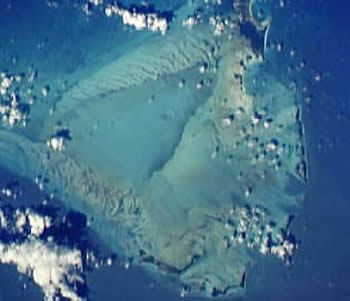 Thirty-four years after NASA's Viking missions to Mars sent back results interpreted to mean there was no organic material - and consequently no life - on the planet, new research has concluded that organic material was found after all.
Thirty-four years after NASA's Viking missions to Mars sent back results interpreted to mean there was no organic material - and consequently no life - on the planet, new research has concluded that organic material was found after all.
The finding does not bring scientists closer to discovering life on Mars, researchers say, but it does open the door to a greater likelihood that life exists, or once existed, on the planet.
New Mars tests find possible life ingredients
Chemical basis for first life theorized
 It's a chicken-and-the-egg puzzle: How could the basic biochemicals like amino acids and nucleotides have come about when there were no catalysts, like proteins or ribosomes, around to create them? Now scientists propose that a third type of catalyst could have jumpstarted metabolism and life itself, deep in hydrothermal ocean vents, an article in The Biological Bulletin says.
It's a chicken-and-the-egg puzzle: How could the basic biochemicals like amino acids and nucleotides have come about when there were no catalysts, like proteins or ribosomes, around to create them? Now scientists propose that a third type of catalyst could have jumpstarted metabolism and life itself, deep in hydrothermal ocean vents, an article in The Biological Bulletin says.
The scientists' theory says molecular structures involving transition metal elements -- iron, copper, nickel, etc. -- and ligands -- small organic molecules -- could have catalyzed the synthesis of basic biochemicals, monomers, that acted as building blocks for more complex molecules, leading ultimately to the origin of life.
Stephen Hawking: God did not create Universe
 There is no place for God in theories on the creation of the Universe, Professor Stephen Hawking has said. He had previously argued belief in a creator was not incompatible with science but in a new book, he concludes the Big Bang was an inevitable consequence of the laws of physics.
There is no place for God in theories on the creation of the Universe, Professor Stephen Hawking has said. He had previously argued belief in a creator was not incompatible with science but in a new book, he concludes the Big Bang was an inevitable consequence of the laws of physics.
The Grand Design, part serialised in the Times, says there is no need to invoke God to set the Universe going. "Spontaneous creation is the reason there is something," he concluded.
Study shakes up scientists' view of San Andreas earthquake risk
 Southern California is long overdue for a major earthquake along the San Andreas fault, according to a landmark study of historic seismic activity released Friday.
Southern California is long overdue for a major earthquake along the San Andreas fault, according to a landmark study of historic seismic activity released Friday.
The study, produced after several years of field studies in the Carrizo Plain area about 100 miles northwest of Los Angeles, found that earthquakes along the San Andreas fault have occurred far more often than previously believed.
Magnetic mega-star discovery challenges black hole theory
 A neutron star with a mighty magnetic field has thrown down the gauntlet to theories about stellar evolution and the birth of black holes, astronomers said today. The "magnetar" lies in a cluster of stars known as Westerlund 1, located 16,000 light years away in the constellation of Ara, the Altar.
A neutron star with a mighty magnetic field has thrown down the gauntlet to theories about stellar evolution and the birth of black holes, astronomers said today. The "magnetar" lies in a cluster of stars known as Westerlund 1, located 16,000 light years away in the constellation of Ara, the Altar.
Westerlund 1, discovered in 1961 by a Swedish astronomer, is a favoured observation site in stellar physics. It is one of the biggest cluster of superstars in the Milky Way, comprising hundreds of very massive stars, some shining with a brilliance of almost a million Suns and some two thousand times the Sun's diameter.
How Brilliant Computer Scientists Solved the Bermuda Triangle Mystery
 According to two research scientists the mystery of vanished ships and airplanes in the region dubbed "The Bermuda Triangle" has been solved.
According to two research scientists the mystery of vanished ships and airplanes in the region dubbed "The Bermuda Triangle" has been solved.
The methane—normally frozen at great pressure as gas hydrates embedded within subterranean rock—can become dislodged and transform into gaseous bubbles expanding geometrically as they explode upwards. When these bubbles reach the surface of the water they soar into the air, still expanding upwards and outwards.
Stars reveal carbon 'spaceballs'
 Scientists have detected the largest molecules ever seen in space, in a cloud of cosmic dust surrounding a distant star. The football-shaped carbon molecules are known as buckyballs, and were only discovered on Earth 25 years ago when they were made in a laboratory.
Scientists have detected the largest molecules ever seen in space, in a cloud of cosmic dust surrounding a distant star. The football-shaped carbon molecules are known as buckyballs, and were only discovered on Earth 25 years ago when they were made in a laboratory.
These molecules are the "third type of carbon" - with the first two types being graphite and diamond.
More Articles...
Page 48 of 61

 Science Glance
Science Glance






























